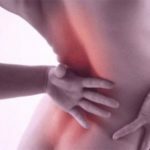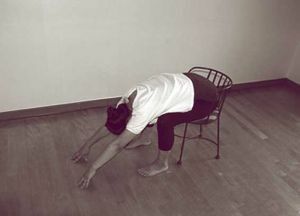 Spondylosis is a disease that leads to changes in the discs and joints of the cervical spine. There is deformation of the vertebrae , proliferation of bone tissue in the form of growths, which degenerate and later there is a narrowing of the vertebral canal, intervertebral foramen.
Spondylosis is a disease that leads to changes in the discs and joints of the cervical spine. There is deformation of the vertebrae , proliferation of bone tissue in the form of growths, which degenerate and later there is a narrowing of the vertebral canal, intervertebral foramen.
When spine-shaped processes( osteophytes) proliferate, the mobility of the vertebrae decreases, and their flexibility is lost. The growth of osteophytes can lead to the fusion of adjacent vertebrae. Spondylosis usually develops in people of advanced age and is chronic. The disease is accompanied by aching, dull pain on the damaged part of the spine.
The most common is cervical spondylosis, since this part of the spine is the most mobile and therefore very often it is the bone changes that occur in it.
The content of the article
- The reasons that trigger the development of the disease
- Symptoms of the disease
- The complex of measures for curing the disease
- Medical treatment of the disease
- The correct massage techniques for spondylosis of the neck
- Physiotherapeutic procedures
- Therapeutic exercises: exercise rules
- The more dangerous the spondylosis of the neck calf
- Video: Complexexercises for the cervical spine
Reasons that trigger the development of the disease
There isthe whole a number of causes of , which alone or in a complex lead to the development of a deforming spondylosis of the cervical spine:
- long stay in a sitting position, with a violation of posture;
- spine trauma;
- excessive physical activity;
- osteochondrosis - intervertebral discs lose elasticity and metabolism is disturbed. To compensate for all this, the body forms discs on the sides of the vertebrae;
- flat feet;
- inflammation of the joints;
- age changes. Early spondylosis, which can manifest itself in 20-40 years, provokes great physical exertion;
- genetic predisposition.
Symptoms of the disease
Symptoms of cervical spondylosis have very characteristic features of :
- pains in the region of the shoulder girdle and occiput, which can be permanent or appear at night. The pain is felt and when it is still, the mobility of the neck is hampered, the pain increases when the head turns, painful sensations in the shoulder joint from the outside. Because of the squeezing of the nerve endings, the pain extends to the hand. Also tingling and numbness of the limbs can be felt;
- pain extending to the ear, eye area and accompanied by visual and hearing impairment with the head and neck still;
- hampered the turns and inclinations of the head;
- loss of neck sensitivity;
- weakness of the neck muscles.
- crunch and discomfort in the neck;
- in the back of the neck is a sensation of pain that extends to the head and occipital part. Increased pain in the morning and afternoon;
- dizziness.
In addition, patients can not find a comfortable pose for sleep, from pain and discomfort in the cervical region often wake up. Through an uncomfortable position, there is an additional burden on the ligaments and joints of the cervical spine and unpleasant sensations are aggravated.
When pressing the back of the intervertebral joint, if the head of the sick person is thrown back, there is a pain.
Complex of measures for curing the disease
Cervical spondylosis is an irreversible process of aging, but it is extremely necessary to improve the patient's condition and prevent the development of possible complications. Thus, complex treatment of spondylosis of the cervical spine looks like this:
Drug medication for
disease- for pain relief to take anti-inflammatory drugs( ibuprofen, diclofenac).
- to limit movement of the neck with the help of cervical corset, collar;
- perform special exercises to strengthen the shoulder and neck muscles, effective aerobics in the water.
When treats severe cases of , it is necessary:
- to comply with bed rest to completely eliminate neck movement and to reduce pressure on nerve endings;
- local anesthesia;
- with muscle spasms it is necessary to take muscle relaxants - cyclobenzaprine, metokarbamol, with acute pain - narcotic drugs.

X-ray of the cervical spondylosis
During the exacerbation of the disease, is used as a medicament for treating - anti-inflammatory and analgesic agents. The treatment is aimed at alleviating the general condition of the patient, eliminating pain, strengthening the muscles of the neck, as well as unloading the cervical spine.
Muscle spasm or pain syndrome will help to remove muscle relaxants ( cyclobenzaprine and tizanidine), analgesics ( tramadol) or narcotic drugs are used to eliminate severe pain.
A good anti-pain and anti-inflammatory effect of is nonsteroidal anti-inflammatory drugs ( ibuprofen, diclofenac, voltaren, movalis), but they do not stop the process of bone formation and the very cause of the disease.
For the treatment of a chronic disease antidepressants are used. Long-term practice has shown that the use of tricyclic antidepressants, including amitriptyline( Elavil) and doxepin( Sinevkan), in small doses is very effective for the treatment of chronic pain. Not so long ago, the antidepressant duloxetine( Simbalta) began to be used. A powerful effect is the use of ointments containing capsaicin.
For the treatment of cervical spondylosis, a single medical method is not enough, in a complex it is necessary to apply physiotherapy, massage and physiotherapy .
 No less painful lumbar spondylosis requires a different approach to treatment. What exactly you can learn from the article on our website.
No less painful lumbar spondylosis requires a different approach to treatment. What exactly you can learn from the article on our website.
If the protrusion in the cervical spine does not allow to live quietly, it is necessary to learn a set of measures to stop pain and cure the disease. Click here for details.
The right massage techniques for spondylosis of the
neck The therapeutic massage is of great importance, which has the following objectives:
- improving blood circulation in the neck, spine and back muscles;
- decrease in the severity of the pain syndrome;
- removal of excessive tension of neck and back muscles;
- strengthening of muscles.
Depending on the clinical picture of the disease and on the stage of the disease, the technique of performing the massage depends, which is developed separately for each sick person, taking into account his condition. At the stage of exacerbation of the disease, the massage is contraindicated.
Massage begins with classic stroking, then proceeds to rubbing and kneading muscle tissue. The duration of the massage is 15-20 minutes. For 15-20 sessions, the pain syndrome is eliminated. It is necessary to exclude effleurage, severe depression and other traumatic methods.
Physiotherapeutic procedures
Very effective method that allows to reduce pain syndrome and improve microcirculation in the tissues of the spine.
Advantages of physiotherapy:
- affects the focus of the disease, and does not affect neighboring organs;
- does not contribute to exacerbation of chronic diseases;
- does not cause an allergic reaction;
- without side effects;
- accelerates the healing process.
Treatment with physiotherapy allows:
- to remove pain and stop the inflammatory process;
- to facilitate and increase the movement of the spine;
- reduce muscle tension;
- partially relieve emotional tension;
- to enhance immunity;
- to promote the normalization of blood circulation in tissues;
- accelerate the recovery process;
- to improve the overall condition.
Physiotherapy in spondylosis can include electrophoresis, magnetotherapy, ultrasound, vibration, electrotherapy, shockwave therapy, laser therapy, detrusor therapy, ultraviolet irradiation, balneotherapy, hirudotherapy.
Contraindications to physiotherapy:
- oncological diseases;
- exacerbations and severe general illness;
- diseases of the respiratory system and cardiovascular system;
- liver and kidney disease;
- skin diseases;
- exacerbation of mental disorders;
- pregnancy.
Physiotherapy exercises: rules for performing exercises
 In this disease, you must exclude sudden movements of the head and neck, and limit excessive loads. When the exercises are systematically performed, the blood circulation in the cervical spine improves, the muscles are in the right tone, the spinal mobility remains.
In this disease, you must exclude sudden movements of the head and neck, and limit excessive loads. When the exercises are systematically performed, the blood circulation in the cervical spine improves, the muscles are in the right tone, the spinal mobility remains.
All exercises should be done with maximum unloading of the spine, that is, in the prone position or, alternatively, on all fours. If the pain is not strong, then the exercises can be performed standing.
The entire curative physical training course aims to reduce the burden on the spine.
Gymnastics for the cervical spine with spondylosis:
- Head inclinations to the right and left, with the arm extending downward along the trunk.
- The starting position is the hands on the back of the head. During exhalation tilt the head forward, touching the sternum with the chin, on inhalation - the starting position, raise the head.
- The starting position is to become straight, feet shoulder-width apart. Raise the shoulders and stand in such a hunched posture for 2-5 seconds.
- Performing circular rotations only with shoulders, palms pressed along the trunk.
- Alternately, connect your hands behind your back in the area of the shoulder blades.



